Fecal culture
Stool culture; Culture - stool; Gastroenteritis fecal culture
A fecal culture is a lab test to find organisms in the stool (feces) that can cause gastrointestinal symptoms and disease.
Images
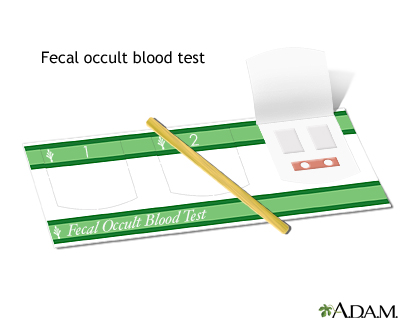
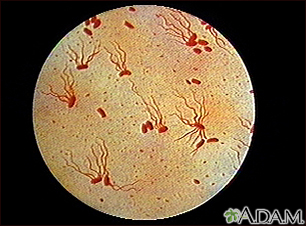
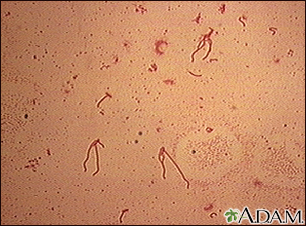
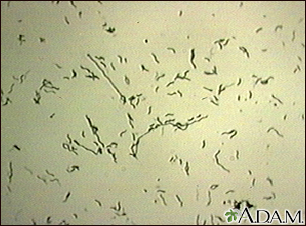
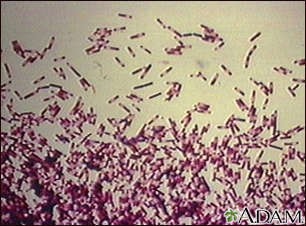
I Would Like to Learn About:
How the Test is Performed
A stool sample is needed.
There are many ways to collect the sample.
You can collect the sample:
- On plastic wrap. Place the wrap loosely over the toilet bowl so that it is held in place by the toilet seat. Put the sample in a clean container given to you by your health care provider.
- In a plastic container for the toilet that the lab may give you.
- In a test kit that supplies a special toilet tissue. Put it in a clean container given to you by your provider.
Do not mix urine, water, or toilet tissue with the sample.
For children wearing diapers:
- Line the diaper with plastic wrap.
- Position the plastic wrap so that it will prevent urine and stool from mixing. This will provide a better sample.
Return the sample to the laboratory as soon as possible. Do not include toilet paper or urine in the specimen.
In the lab, a technician places a sample of the specimen in a special dish. The dish is then filled with a gel that boosts the growth of bacteria or other germs. If there is growth, the germs are identified. The lab technician may also do more tests to determine the best treatment.
How to Prepare for the Test
You will get a collection container for the stool specimen. Depending on the stool tests ordered, you may be given multiple collection bottles. They may have different instructions. Read everything ahead of time, and make sure to follow all instructions carefully.
How the Test will Feel
There is no discomfort.
Why the Test is Performed
The test is performed when your health care provider suspects that you may have a gastrointestinal infection. It may be done if you have severe diarrhea that does not go away or that keeps coming back.
Normal Results
There are no abnormal bacteria or other organisms in the sample.
What Abnormal Results Mean
Abnormal results may mean you have an intestinal infection. Talk to your provider about the meaning of your specific test results.
Risks
There are no risks.
Considerations
Often other stool tests are done in addition to the culture, such as:
Related Information
DiarrheaBacterial gastroenteritis
Cryptosporidium enteritis
References
Fleckenstein JM. Approach to the patient with suspected enteric infection. In: Goldman L, Cooney KA, eds. Goldman-Cecil Medicine. 27th ed. Philadelphia, PA: Elsevier; 2024:chap 262.
Melia JMP, Sears CL. Infectious enteritis and proctocolitis. In: Feldman M, Friedman LS, Brandt LJ, eds. Sleisenger and Fordtran's Gastrointestinal and Liver Disease.11th ed. Philadelphia, PA: Elsevier; 2021:chap 110.
Siddiqi HA, Rabinowitz S, Axiotis CA. Laboratory diagnosis of gastrointestinal and pancreatic disorders. In: McPherson RA, Pincus MR, eds. Henry's Clinical Diagnosis and Management by Laboratory Methods. 24th ed. Philadelphia, PA: Elsevier; 2022:chap 23.
Wojewoda CM, Stempak LM. Medical bacteriology. In: McPherson RA, Pincus MR, eds. Henry's Clinical Diagnosis and Management by Laboratory Methods. 24th ed. Philadelphia, PA: Elsevier; 2022:chap 57.
BACK TO TOPReview Date: 6/11/2024
Reviewed By: Jenifer K. Lehrer, MD, Department of Gastroenterology, Aria - Jefferson Health Torresdale, Jefferson Digestive Diseases Network, Philadelphia, PA. Review provided by VeriMed Healthcare Network. Also reviewed by David C. Dugdale, MD, Medical Director, Brenda Conaway, Editorial Director, and the A.D.A.M. Editorial team.

Health Content Provider
06/01/2025
|
A.D.A.M., Inc. is accredited by URAC, for Health Content Provider (www.urac.org). URAC's accreditation program is an independent audit to verify that A.D.A.M. follows rigorous standards of quality and accountability. A.D.A.M. is among the first to achieve this important distinction for online health information and services. Learn more about A.D.A.M.'s editorial policy, editorial process and privacy policy. A.D.A.M. is also a founding member of Hi-Ethics. This site complied with the HONcode standard for trustworthy health information from 1995 to 2022, after which HON (Health On the Net, a not-for-profit organization that promoted transparent and reliable health information online) was discontinued. |
The information provided herein should not be used during any medical emergency or for the diagnosis or treatment of any medical condition. A licensed medical professional should be consulted for diagnosis and treatment of any and all medical conditions. Links to other sites are provided for information only -- they do not constitute endorsements of those other sites. © 1997- 2025 A.D.A.M., a business unit of Ebix, Inc. Any duplication or distribution of the information contained herein is strictly prohibited.
